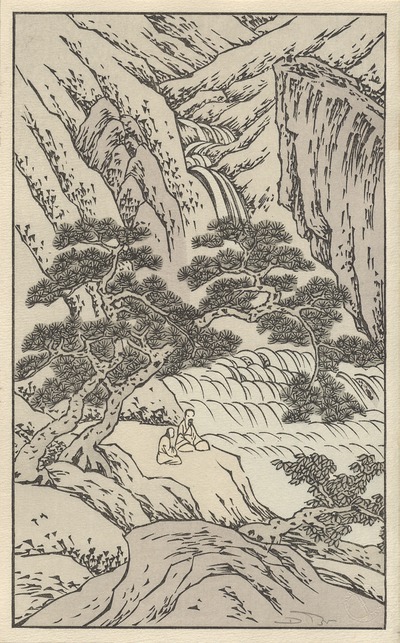Nanga Landscape (南画) Designer: Nakabayashi Chikuto | Carver: David Bull | Printer: Rei Paper size: 22cm by 13.5cm | Enlargement | Shipping Code: [M] ? ( Change currency: $ / £ / € ) Price:   Description: [Notes from Dave’s original publication of this image in his Surimono Album series:] The image was created by Nakabayashi Chikuto, and was published in a collection of his designs Chikuto Sansui Gako in 1812. He worked in what is known as the Nanga (Southern painting) style, which - as you can see - owed much to its origins in Chinese painting. When I learned that Chinese painting in the previous centuries was divided between 'Northern' and 'Southern' schools, I assumed that this was a geographical distinction, but this was apparently not the case. The division was by style, not location - Northern painting was focussed on details and was more colourful, while Southern painting was of a sort that is always described with the same word - 'impressionistic'. In a typical Nanga-style landscape some particular object forms the focus around which the rest is framed. Here of course it is the figures of the two men sitting by the stream. The actual scene is (we assume) completely imaginary; this is no particular mountain. The idea was to create an 'impression' of the elements - tree, rock, flowing water - to show their inner spirit, and not to depict them with any intent of realism. I think it quite succeeds in this; you viewers will be looking at this print probably for only a few minutes, and may feel that it is 'a nice peaceful scene', but during the weeks of work it takes me to make a print like this, I 'look' at it for many hours indeed, and I can tell you that it does indeed repay time spent ... I now 'know' what it feels like to sit by the riverbank in this deep and distant valley ... Although this print also could technically be described as a sumizuri-e (black printed picture), it is actually tashoku-zuri (multi-coloured printing). There are eight impressions, using nothing but sumi (with the exception of a faint splash of sepia on the clothing of the two men). So where do all the different shades come from? Well, there is sumi and there is sumi. When I first started out in Japanese printmaking, I used standard bokuju (pre-mixed liquid sumi) for all my work. It made a basic black, and I learned that by diluting it with water, I could get basic greys. As time went by though, I learned that many different types of sumi were available, each one having its own particular tone or shade. This is of course not 'news' to most Japanese readers, because they have been choosing sumi to use for their calligraphy since they were children, but my eyes - as I suspect would be the case with most westerners - simply hadn't seen the differences. To prepare for making this print, I visited a sumi shop, and spent time browsing through their iro-mihon (colour sample book). I also learned that in addition to the many colours available with sumi, there is an incredible price range - some of the more rare and 'famous name' sumi types seemed to cost as much as an equivalent bar of gold! Please don't feel disappointed that I didn't choose from that type ... I brought home a number of different types of sumi, some specifically named - ao-zumi (blue sumi) for example - and a selection of various 'just plain' sumi inks. I had fun balancing and mixing them to make an attractive print; the combinations are quite literally endless, and I am sure that another printmaker would have come up with a completely different palette. I think that this is actually much more difficult than working with 'normal' colours; to put green pigment on a block and make you see green pine needles is not so difficult, but to put grey on a block and make you see green pine needles is a bit more of a challenge!   Browse thumbnail pages of various selections from the catalogue ... Mokuhankan Publications:general (104) kacho-e (27) landscape (54) bijin-ga (19) contemporary (17) senshafuda (2) yakusha-e (4) HangaClub (70) ebook (6) miscellaneous (4) 8 Cats (4) supplies (6) [ Also see our Annual Gift Page ] Partner Shops: Kawase Hasui prints (14) Yoshida family prints (40) Doi Hanga prints (15) Miyakodori prints (11) Numabe Mokuhan prints (3) Guest items (17) Mokuhankan Flea Market (All items) general (59) kacho-e (25) yakusha-e (22) landscape (117) bijin-ga (77) kuchi-e (2) contemporary (4) set (39) books (4) (Recently sold items) |
||